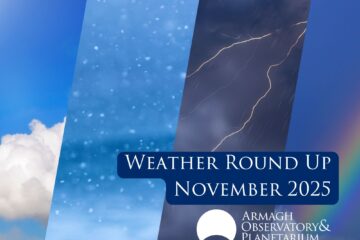During December we will be able to start stargazing from earlier in the evenings, weather permitting of course. This means that on clear nights we get a view of more stars and objects in the night sky; but it is better to be prepared for the colder weather (and more than likely rain if you are in Armagh). To help with stargazing we want to leave the city lights behind and find a spot with less light pollution. Then it is helpful to keep phones away to let your eyes adapt to the dark, so you can see more of those stars that appear faint to the naked eye.
The sun will be setting much earlier during this month than in the previous ones, so hopefully that gives us more time to get some stargazing in before bed. Let’s turn our gaze to the sky now and look for some celestial patterns.
Constellations
At this time of the year, we have the gift of darker skies sooner in the evening for looking to the stars. While it is nice to have sunshine during the summer, it is a confounding variable for seeing any stars in the evening sky. So, what will we see for December? There will be a mix of famous and lesser-known constellations up there. Plus, some that linger from the last couple of months.
Starting with Aquarius in our Southern sky early in the month, this well-known zodiac constellation will be the backdrop for one of the giants of the solar system. Saturn will be visible here around 7pm, hopefully long enough after the sun has set.
Another constellation that I am quite fond of is Canis Major, the Big Dog. When we see the stick figure it does, almost, look like a silhouette of a dog, but like other constellations imagination is required. Our Big Dog never rises far from the horizon as we see it in Armagh, so keep an eye on the low Southern sky for this one. This particular constellation is also home to Sirius, the star that appears the brightest in the night sky with an apparent visual magnitude (the measure of how bright a cosmic object is from Earth) of –1.45. The lower the number the brighter the object – it is a reverse logarithmic scale.
If you look towards Gemini around the 14th of December, you might see some meteors during the peak of the Geminids. However, the light from the moon could act like a floodlight and reduce the actual number to below the possible 140 per hour.
Deep Sky Objects (DSO)
The Iris Nebula (NGC 7023), at 1300 lightyears distant, is visible in the Northern sky in the constellation of Cepheus the King, which is a circumpolar constellation from here in Armagh. This means it should be visible throughout the year if the night is dark enough. Like most DSOs this one is very faint to the naked eye, but telescopes help and having a camera attached can aid you in seeing more colour by capturing more light on long exposures.
Sticking with Cepheus, we can find the Wizard Nebula (NGC7380), a name after my own heart. This one is a red nebula about 5,500 lightyears from Earth with a low magnitude (~7), so again some help will be needed. Nebulae can be very colourful, but hard to see.
Deep sky objects also encompass star clusters, some of which are very easily spotted with a pair of binoculars or a small telescope.
The Moon
The Full Moon for December will be on the 15th of the month, close to the Pleiades with Taurus as a background. During December, the full moon is known as the Cold moon, signifying the darkest and coldest time of the Northern Hemisphere year. The full moon does offer some light, reflected from the sun, on these dark nights . Then on December 30th we will have the New Moon phase, which will mean that when we have fireworks over the coming days they will be on the background of a darker sky, so on this night stargazing may become quite a challenge unless you are well into the countryside.
On the 18th you might also spot the Moon come close to Mars just a few days after the full moon phase, but it will be close to 3am to see this best.
The Winter Solstice
December is full of celestial bodies to look for from planets, stars, nebulae and meteor showers, but there is an event that happens yearly that is worth mentioning. The solstice on the 22nd of December. This will be the day that we see the sun take its lowest path across the sky, leading to the day with the least amount of sunlight. So, less daylight and longer nights, usually leading to more time to observe the skies. There are neolithic sites dedicated in some part to this yearly occurrence, such as Newgrange in County Meath, Ireland. Each year the passage is lit by the rising sun around the days of the solstice. This requires careful planning and devoted construction of such sites with an excellent understanding of exactly which day the solstice will occur and where the sun will rise on that day.









1 Comment
Kieran · December 12, 2024 at 09:50
Good to see you Mark mentioning the Winter Solstice, rather than the more obvious upcoming Christian Festival celebration.
More things like this during the year, for example how the old tribes called this month’s full moon the “Cold Moon” and other origins would be great.